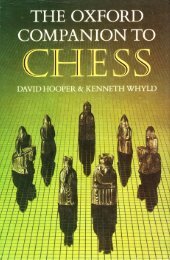You also want an ePaper? Increase the reach of your titles
YUMPU automatically turns print PDFs into web optimized ePapers that Google loves.
ioumament 1896. this defe.ce w6 used trequently<br />
during the <strong>to</strong>unanenl held in 1904 at Cambridge<br />
Springs, a spa inPennsylvania. ALEGINEnadeu*<br />
of this defen@ fiv. times in the World Cbam<br />
pionship natch of 1927, since {hen n hd oc@lrcd<br />
less often, pa.tly because While usually plars the<br />
ExcnANcE va{^rloN, 83. (See (ASHDAN.)<br />
CAMDL, an unorthodox LBPER used in sonc<br />
lorns of crEAr cH.ss. Tbe co ordinates of its leaps<br />
are 3.1. and rhe length ofits movc V10. A canel<br />
attacks from t*o 10 eight squares on lhe nornal<br />
board depending on its position. II pla@d on d4 it<br />
wonld attacl( a3, a5, c7, e7,85,93, el, andc1. (In<br />
Tibet and Mongolia camel is the .ane used for the<br />
CAMPBELL VARTATION, 610, a defen@ lo th€<br />
rEEmz(! cdBlr devised arou.d 1860 <strong>by</strong> Joseph<br />
Graham canpbell (1830-91), a problenist and<br />
one oI London\ strongesl playe6. Als tno{n as<br />
Brentano Derence or (E.) Mor?hy variation.<br />
CAMPOMANES,FLORENCIO(1927 ),aFiIi.<br />
pino who reprcsenled his ounlry !t list board in<br />
the L.ipzig oLYMN, 1960, and sDcceeded olss<br />
soN as president ofEDE in 1982.<br />
CANAL, ESTEBAN (18% 1981), Inter.ational<br />
Grandmasier (197). Bom in Peru, whe.e he spenr<br />
the lirst 26 years of his life. hc had few opportuni<br />
ries <strong>to</strong> delelop his talenr during his youtb. He came<br />
<strong>to</strong> Europe in 1923 and in that year madc his<br />
inlernational d;bul at the Trieste lour.anenl.<br />
taking se@nd place aftcr H. rorNER. His best<br />
<strong>to</strong>umanent achievenents were in 1933 whef, he<br />
came thnd (+3:l 1) after E. srE,NER and<br />
rLrsKAsEs at Ke6kem€t and look fist p.ize ahead<br />
of LrLrEWr, L. SENDR, Eliskases, and E.<br />
Steiner at Budapesl, Strbseqnently he Played in<br />
nany mino. evenls wirh varying success and for tb€<br />
Peruvian team at the Dubrovni* Olympiad, 1950.<br />
Canal P. Johner Carlsbad 1929 l.aliaa Openins. Canal<br />
variation<br />
1e4e5 2NBNC6 3Nc3Nl6.1Bc4B.5 5d3d6 6895<br />
h6 TBr.lriQ6 3Nd5Qd3 9dNe7 10d4exd4 ll<br />
Nxd4Nxd5 128xd50.0 llQdlQ6 r4Bb3Re3 150'0<br />
Be6 16 8.2 g6 17 rhl Rads 1314 Bd7 19 f5 35<br />
20Ne6tie6 2lt\e6Qg6 22eid7Rxd7 23Rf5R.ie7 24<br />
RallKpT 25e5Rh3 26e6oxe6 27RJ6 Blackresipns<br />
CAPABLANCA 55<br />
CANAL VARJATION, 492 in tbe daLN oENINc,<br />
line rei.troduced <strong>by</strong>CANALin 1929 *irh a new idea<br />
innind(6.. .h6 7Bxl6Qxf6 8N(t5Od8 9c3)i<br />
88, the Venic€ Va.iation ol the ouE.Nt GdBr<br />
CANDIDATE, (1) NNzo\mcs\ name Io! a Bu<br />
CANDIDATE, (2) one oi a Sroup of playcrs who<br />
conpeles in the 6nal eliminaring contest lor the<br />
right lo chalenge the world ch<strong>amp</strong>ion. To be@me<br />
a candidate a player must quality in an ImRzoNAL<br />
rclRNAMTNt orind, other man.er p.escribed <strong>by</strong><br />
FIDE. To decide who should be ch.uenger nve<br />
candidates <strong>to</strong>urnaments were held (sinnc6 in<br />
brackek): Budapest 1950 (BIoN$EIN afie. a<br />
pla!-oft), Neuhausen zuflch tgsl GMlsDv),<br />
amsrerdam lq5o (Smyslo\), Bled Zagreb Bclsrade<br />
1959 (rar), and curaEao 1962 (EBosvaN).<br />
Sin e then Candidales, linited 10 eight in nnmbe.,<br />
have played matches on a knock-out basis every<br />
ihr.ev$rs <strong>The</strong> nnen ofthe final narches who<br />
ihus 6ecanc challeneeG sere spAssn (1965,<br />
1968), EscHDR (1971), xARtuv (1974), rcicsNol<br />
(1977, 1980), and tusP^Rov (1984).<br />
CANDIDATE MAS'ITR, a national litle i. ene<br />
@unhies, ranking inmediaiely below thal of<br />
CaPABLANCA, JOSE RA0L (1888 1912),<br />
World Ch<strong>amp</strong>ion 1921 7. Bom in Ctba, the<br />
second suNivi.g son oI an arny ofli@r. hc learnt<br />
<strong>chess</strong> at rhe age of four but wa nol allowed lo play<br />
frequently uolil the autunn oi 1901, Nhen he<br />
defeated Juan cozo (187!1938) in an informal<br />
match (+,1:6 3). (Four monlhs latc. when J.<br />
corzo won fie nrst national ch<strong>amp</strong>ionship capablanca<br />
<strong>to</strong>ok foudh place.) A cuban inddrialisl<br />
peking manage.ial talent ofered 10 pay for<br />
Capablanca's edDcadon in the USA, andthere he<br />
senl <strong>to</strong> scbool in 1904 and <strong>to</strong> Colunbia Universiry<br />
in 1906. Duane len and holidays alike C.pa<br />
blanca spent much spare tine at the Manhattan<br />
Ches Club where he played htrndreds of friendly<br />
gdnes againsl the leading playe.s of Ne* York.<br />
<strong>The</strong>re <strong>to</strong>o he played many gmes against ksER,<br />
then World Chanpion, fro6 sbom he leamt <strong>to</strong><br />
app.oach the game pragmatically rather than with<br />
tbe preconceived ide6 that characterted the<br />
teachi.es ol rARes.d. Even in hn studenl days<br />
CapablancashowedouBlandingENDGAMEskilland<br />
a. ertraordinarily quick srcHr oF GE Bo*D.<br />
(Writine in 1946,<br />
^G$NE<br />
stated that he had<br />
neve. seen in anr otherplayer such a'flabbe.sasti.g<br />
quicknes ol <strong>chess</strong> comprehe.siotr'.) Capa<br />
blanca was studying engineering, vhich he lound<br />
oncrous, especially disliking draughtsma.ship<br />
because ihe dravings which had <strong>to</strong> l,c p.epared so<br />
careluly would have no u* aftg the nachines had<br />
been nade frcm them; whateve. ends he sought he<br />
foud tne neans iedious, and olte. skinped them:




